Assessing the Potential Impacts of Climate Change on Drought in Uzbekistan: Findings from RCP and SSP Scenarios
Abstract
:1. Introduction
2. Materials and Methods
2.1. Study Domain
2.2. The Climate Research Unit Observation Data
2.3. The ERA5 Reanalysis
2.4. RCP Scenarios
2.5. SSP Scenarios
2.6. CMIP5/CMIP6 Model Dataset
2.7. The SPEI Drought Index
2.8. Definition of Specific Periods
3. Results
3.1. Climate Model Bias Correction
3.2. Time Series Analysis of Historical and Climate Projection Datasets
3.3. Spatial Variations of Projected Temperature and Precipitation
3.4. Seasonal Anomaly According to Climate Projection Simulations
3.5. Projected Variations of the SPEI Index
4. Discussion
5. Conclusions
Author Contributions
Funding
Institutional Review Board Statement
Informed Consent Statement
Data Availability Statement
Acknowledgments
Conflicts of Interest
Appendix A
| # | Model | Name of the Development Center or Institute | Grid Resolution. The Number of Grid Cells by Latitude and Longitude |
|---|---|---|---|
| 1 | BCC-CSM1-1 | BCC, CMA | 64 × 128 |
| 2 | BCC-CSM1-1-m | BCC, CMA | 160 × 320 |
| 3 | BNU-ESM | BNU | 64 × 128 |
| 4 | CanESM2 | CCCMA | 64 × 128 |
| 5 | CCSM4 | NCAR | 192 × 288 |
| 6 | CESM1-CAM5 | NCAR | 192 × 288 |
| 7 | CESM1-WACCM | NCAR | 96 × 144 |
| 8 | CNRM-CM5 | CNRM | 128 × 256 |
| 9 | CSIRO-Mk3-6-0 | CSIRO | 96 × 192 |
| 10 | EC-EARTH | EC-Earth-Consortium | 160 × 320 |
| 11 | FGOALS-g2 | CAS | 60 × 128 |
| 12 | FIO-ESM | FIO-QLNM | 64 × 128 |
| 13 | GFDL-CM3 | NOAA-GFDL | 90 × 144 |
| 14 | GFDL-ESM2G | NOAA-GFDL | 90 × 144 |
| 15 | GFDL-ESM2M | NOAA-GFDL | 90 × 144 |
| 16 | GISS-E2-H | NASA-GISS | 90 × 144 |
| 17 | GISS-E2-R | NASA-GISS | 90 × 144 |
| 18 | HadGEM2-AO | MOHC | 145 × 192 |
| 19 | HadGEM2-ES | MOHC | 145 × 192 |
| 20 | INM-CM4 | INM | 180 × 120 |
| 21 | IPSL-CM5A-LR | IPSL | 96 × 96 |
| 22 | IPSL-CM5A-MR | IPSL | 143 × 144 |
| 23 | MIROC5 | JAMSTEC, AORI, NIES | 128 × 256 |
| 24 | MIROC5-ESM | JAMSTEC, AORI, NIES | 64 × 128 |
| 25 | MIROC5-ESM-CHEM | JAMSTEC, AORI, NIES | 64 × 128 |
| 26 | MPI-ESM-LR | MPI-M | 96 × 192 |
| 27 | MPI-ESM-MR | MPI-M | 96 × 192 |
| 28 | MRI-CGCM3 | MRI | 160 × 320 |
| 29 | NorESM1-M | NCC | 96 × 144 |
| 30 | NorESM1-ME | NCC | 96 × 144 |
| # | Model | Name of the Development Center or Institute | Grid Resolution. The Number of Grid Cells by Latitude, Longitude, and Altitude (Top Level of the Vertical Grid) |
|---|---|---|---|
| 1 | AWI-CM-1-1-MR | AWI | 384 × 192 × 95 (80 km) |
| 2 | BCC-CSM2-MR | BCC | 320 × 160 × 46 (1.46 hPa) |
| 3 | CAMS-CSM1-0 | CAMS | 320 × 160 × 31 (10 mb) |
| 4 | CanESM5 | CCCMA | 128 × 64 × 49 (1 hPa) |
| 5 | CESM2 | NCAR | 288 × 192 × 32 (2.25 mb) |
| 6 | CESM2-WACCM | NCAR | 288 × 192 × 70 (4.5×10−6 mb) |
| 7 | CIESM | THU | 288 × 192 × 30 (2.255 hPa) |
| 8 | CMCC-CM2-SR5 | CMCC | 288 × 192 × 30 (2 hPa) |
| 9 | EC-Earth3 | EC-Earth-Consortium | 512 × 256 × 91 (0.01 hPa) |
| 10 | EC-Earth3-Veg | EC-Earth-Consortium | 512 × 256 × 91 (0.01 hPa) |
| 11 | FGOALS-f3-L | CAS | 360 × 180 × 32 (2.16 hPa) |
| 12 | FGOALS-g3 | CAS | 80 × 80 × 26 (2.19 hPa) |
| 13 | FIO-ESM-2-0 | FIO-QLNM | 192 × 288 × 26 (2 hPa) |
| 14 | GFDL-CM4 | NOAA-GFDL | 360 × 180 × 33 (1 hPa) |
| 15 | GFDL-ESM4 | NOAA-GFDL | 360 × 180 × 49 (1 Pa) |
| 16 | INM-CM4-8 | INM | 180 × 120 × 21 (0.01 σ) |
| 17 | INM-CM5-0 | INM | 180 × 120 × 73 (0.0002 σ) |
| 18 | IPSL-CM6A-LR | IPSL | 144 × 143 × 79 (80 km) |
| 19 | KACE-1-0-G | NIMS-KMA | 92 × 144 × 85 (85 km) |
| 20 | KIOST-ESM | KIOST | 192 × 96 × 32 (2 hPa) |
| 21 | MIROC6 | MIROC | 256 × 128 × 81 (0.004 hPa) |
| 22 | MPI-ESM1-2-HR | MPI-M, DWD, DKRZ | 384 × 192 × 95 (0.01 hPa) |
| 23 | MPI-ESM1-2-LR | MPI-M, AWI | 192 × 96 × 47 (0.01 hPa) |
| 24 | MRI-ESM2-0 | MRI | 192 × 96 × 80 (0.01 hPa) |
| 25 | NESM3 | NUIST | 192 × 96 × 47 (1 Pa) |
| 26 | NorESM2-LM | NCC | 144 × 96 × 32 (3 mb) |
| 27 | NorESM2-MM | NCC | 288 × 192 × 32 (3 mb) |
- AORI (Atmosphere and Ocean Research Institute, Japan);
- AWI (Alfred Wegener Institute, Germany);
- BCC (Beijing Climate Center, China);
- BNU (Beijing Normal University, China);
- CAMS (Chinese Academy of Meteorological Sciences, China)
- CAS (Chinese Academy of Sciences, China);
- CCCMA (Canadian Centre for Climate Modelling and Analysis, Canada);
- CMCC (Centro Euro-Mediterraneo per I Cambiamenti Climatici);
- CMA (China Meteorological Administration, China);
- CSIRO (Commonwealth Scientific and Industrial Research Organization, Australia);
- DWD (German Meteorological Service, Germany);
- DKRZ (German Climate Computing Center, Germany);
- EC-Earth-Consortium (EU);
- FIO-QLNM (First Institute of Oceanography (FIO) and Qingdao National Laboratory for Marine Science and Technology (QNLM), China);
- INM (Institute of Numerical Mathematics, Russia);
- IPSL (Institut Pierre-Simon Laplace, France);
- JAMSTEC (Japan Agency for Marine-Earth Science and Technology);
- KIOST (Korean Institute of Ocean Science and Technology, Korea);
- MOHC (Met Office Hadley Center, UK);
- MPI-M (Max Planck Institute for Meteorology, Germany);
- MRI (Meteorological Research Institute, Japan);
- NASA-GISS (NASA Goddard Institute for Space Studies, USA);
- NCAR (National Center for Atmospheric Research, USA);
- NCC (Norwegian Climate Centre, Norway);
- NERC (Natural Environmental Research Council);
- NIES (National Institute for Environmental Studies);
- NIMS-KMA (National Institute of Meteorological Sciences/Korea Met. Administration, Korea);
- NOAA-GFDL (National Oceanic and Atmospheric Administration, Geophysical Fluid Dynamics Laboratory, USA);
- NUIST (Nanjing University of Information Science and Technology, China);
- THU (Tsinghua University–Department of Earth System Science, China).
References
- Cao, L.; Xu, C.; Suo, N.; Song, L.; Lei, X. Future Dry-Wet Climatic Characteristics and Drought Trends over Arid Central Asia. Front. Earth Sci. Chin. 2023, 11, 1102633. [Google Scholar] [CrossRef]
- Rakovec, O.; Samaniego, L.; Hari, V.; Markonis, Y.; Moravec, V.; Thober, S.; Hanel, M.; Kumar, R. The 2018–2020 Multi-year Drought Sets a New Benchmark in Europe. Earths Future 2022, 10, e2021EF002394. [Google Scholar] [CrossRef]
- Wu, G.; Chen, J.; Shi, X.; Kim, J.-S.; Xia, J.; Zhang, L. Impacts of Global Climate Warming on Meteorological and Hydrological Droughts and Their Propagations. Earths Future 2022, 10, e2021EF002542. [Google Scholar] [CrossRef]
- Pörtner, H.O.; Roberts, D.C.; Poloczanska, E.S.; Mintenbeck, K.; Tignor, M.; Alegría, A.; Craig, M.; Langsdorf, S.; Löschke, S.; Möller, V.; et al. IPCC, 2022: Summary for Policymakers. In Climate Change 2022: Impacts, Adaptation, and Vulnerability: Contribution of Working Group II to the Sixth Assessment Report of the Intergovernmental Panel on Climate Change; Pörtner, H.O., Roberts, D.C., Poloczanska, E.S., Mintenbeck, K., Craig, M., Langsdorf, S., Löschke, S., Möller, V., Okem, A., Rama, B., Eds.; Cambridge University Pres: Cambridge, UK; New York, NY, USA, 2022; pp. 3–33. ISBN 9789291691593. [Google Scholar]
- Pendergrass, A.G.; Knutti, R. The Uneven Nature of Daily Precipitation and Its Change. Geophys. Res. Lett. 2018, 45, 11980–11988. [Google Scholar] [CrossRef]
- Wang, T.; Tu, X.; Singh, V.P.; Chen, X.; Lin, K. Global Data Assessment and Analysis of Drought Characteristics Based on CMIP6. J. Hydrol. 2021, 596, 126091. [Google Scholar] [CrossRef]
- Eyring, V.; Bony, S.; Meehl, G.A.; Senior, C.A.; Stevens, B.; Stouffer, R.J.; Taylor, K.E. Overview of the Coupled Model Intercomparison Project Phase 6 (CMIP6) Experimental Design and Organization. Geosci. Model Dev. 2016, 9, 1937–1958. [Google Scholar] [CrossRef]
- Taylor, K.E.; Stouffer, R.J.; Meehl, G.A. An Overview of CMIP5 and the Experiment Design. Bull. Am. Meteorol. Soc. 2012, 93, 485–498. [Google Scholar] [CrossRef]
- O’Neill, B.C.; Kriegler, E.; Ebi, K.L.; Kemp-Benedict, E.; Riahi, K.; Rothman, D.S.; van Ruijven, B.J.; van Vuuren, D.P.; Birkmann, J.; Kok, K.; et al. The Roads Ahead: Narratives for Shared Socioeconomic Pathways Describing World Futures in the 21st Century. Glob. Environ. Change 2017, 42, 169–180. [Google Scholar] [CrossRef]
- O’Neill, B.C.; Tebaldi, C.; van Vuuren, D.; Eyring, V.; Friedlingstein, P.; Hurtt, G.; Knutti, R.; Kriegler, E.; Lamarque, J.-F.; Lowe, J.; et al. The Scenario Model Intercomparison Project (ScenarioMIP) for CMIP6. Geosci. Model Dev. Discuss. 2016, 9, 3461–3482. [Google Scholar] [CrossRef]
- Tebaldi, C.; Debeire, K.; Eyring, V.; Fischer, E.; Fyfe, J.; Friedlingstein, P.; Knutti, R.; Lowe, J.; O’Neill, B.; Sanderson, B.; et al. Climate Model Projections from the Scenario Model Intercomparison Project (ScenarioMIP) of CMIP6. Earth Syst. Dyn. 2021, 12, 253–293. [Google Scholar] [CrossRef]
- Liu, F.; Xu, C.; Long, Y.; Yin, G.; Wang, H. Assessment of CMIP6 Model Performance for Air Temperature in the Arid Region of Northwest China and Subregions. Atmosphere 2022, 13, 454. [Google Scholar] [CrossRef]
- Riahi, K.; van Vuuren, D.P.; Kriegler, E.; Edmonds, J.; O’Neill, B.C.; Fujimori, S.; Bauer, N.; Calvin, K.; Dellink, R.; Fricko, O.; et al. The Shared Socioeconomic Pathways and Their Energy, Land Use, and Greenhouse Gas Emissions Implications: An Overview. Glob. Environ. Change 2017, 42, 153–168. [Google Scholar] [CrossRef]
- Hu, X.-M.; Ma, J.-R.; Ying, J.; Cai, M.; Kong, Y.-Q. Inferring Future Warming in the Arctic from the Observed Global Warming Trend and CMIP6 Simulations. Adv. Clim. Change Res. 2021, 12, 499–507. [Google Scholar] [CrossRef]
- Jaiswal, R.; Mall, R.K.; Singh, N.; Lakshmi Kumar, T.V.; Niyogi, D. Evaluation of Bias Correction Methods for Regional Climate Models: Downscaled Rainfall Analysis over Diverse Agroclimatic Zones of India. Earth Space Sci. 2022, 9, e2021EA001981. [Google Scholar] [CrossRef]
- Lioubimtseva, E.; Henebry, G.M. Climate and Environmental Change in Arid Central Asia: Impacts, Vulnerability, and Adaptations. J. Arid Environ. 2009, 73, 963–977. [Google Scholar] [CrossRef]
- Zhang, M.; Chen, Y.; Shen, Y.; Li, B. Tracking Climate Change in Central Asia through Temperature and Precipitation Extremes. J. Geogr. Sci. 2019, 29, 3–28. [Google Scholar] [CrossRef]
- Li, Y.; Chen, Y.; Li, Z. Dry/Wet Pattern Changes in Global Dryland Areas over the Past Six Decades. Glob. Planet. Change 2019, 178, 184–192. [Google Scholar] [CrossRef]
- Miao, L.; Li, S.; Zhang, F.; Chen, T.; Shan, Y.; Zhang, Y. Future Drought in the Dry Lands of Asia under the 1.5 and 2.0 °C Warming Scenarios. Earths Future 2020, 8, e2019EF001337. [Google Scholar] [CrossRef]
- Wang, J.; Chen, F.; Jin, L.; Bai, H. Characteristics of the Dry/Wet Trend over Arid Central Asia over the Past 100 Years. Clim. Res. 2010, 41, 51–59. [Google Scholar] [CrossRef]
- Li, H.; Li, Z.; Chen, Y.; Liu, Y.; Hu, Y.; Sun, F.; Kayumba, P.M. Projected Meteorological Drought over Asian Drylands under Different CMIP6 Scenarios. Remote Sens. 2021, 13, 4409. [Google Scholar] [CrossRef]
- Luo, M.; Liu, T.; Meng, F.; Duan, Y.; Bao, A.; Frankl, A.; De Maeyer, P. Spatiotemporal Characteristics of Future Changes in Precipitation and Temperature in Central Asia. Int. J. Climatol. 2019, 39, 1571–1588. [Google Scholar] [CrossRef]
- Yao, L.; Zhou, H.; Yan, Y.; Li, L.; Su, Y. Projection of Hydrothermal Condition in Central Asia under Four SSP-RCP Scenarios. J. Arid Land 2022, 14, 521–536. [Google Scholar] [CrossRef]
- Ta, Z.; Li, K.; Yu, Y.; Yang, M. Projections of Future Drought by CMIP5 Multimodel Ensembles in Central Asia. Atmosphere 2022, 13, 232. [Google Scholar] [CrossRef]
- Hua, L.; Zhao, T.; Zhong, L. Future Changes in Drought over Central Asia under CMIP6 Forcing Scenarios. J. Hydrol. Reg. Stud. 2022, 43, 101191. [Google Scholar] [CrossRef]
- Dai, A. Characteristics and Trends in Various Forms of the Palmer Drought Severity Index during 1900–2008. J. Geophys. Res. 2011, 116, D12115. [Google Scholar] [CrossRef]
- Li, H.; Li, Z.; Chen, Y.; Xiang, Y.; Liu, Y.; Kayumba, P.M.; Li, X. Drylands Face Potential Threat of Robust Drought in the CMIP6 SSPs Scenarios. Environ. Res. Lett. 2021, 16, 114004. [Google Scholar] [CrossRef]
- Jiang, J.; Zhou, T.; Chen, X.; Zhang, L. Future Changes in Precipitation over Central Asia Based on CMIP6 Projections. Environ. Res. Lett. 2020, 15, 054009. [Google Scholar] [CrossRef]
- Hu, Z.; Zhang, C.; Hu, Q.; Tian, H. Temperature Changes in Central Asia from 1979 to 2011 Based on Multiple Datasets. J. Clim. 2014, 27, 1143–1167. [Google Scholar] [CrossRef]
- Zhang, Q.; Han, L.; Jia, J.; Song, L.; Wang, J. Management of Drought Risk under Global Warming. Theor. Appl. Climatol. 2016, 125, 187–196. [Google Scholar] [CrossRef]
- Hu, Q.; Han, Z. Northward Expansion of Desert Climate in Central Asia in Recent Decades. Geophys. Res. Lett. 2022, 49, e2022GL098895. [Google Scholar] [CrossRef]
- Sheffield, J.; Wood, E.F.; Roderick, M.L. Little Change in Global Drought over the Past 60 Years. Nature 2012, 491, 435–438. [Google Scholar] [CrossRef]
- Orlovsky, N.S.; Orlovsky, L.; Indoitu, R. Severe Dust Storms in Central Asia. Arid Ecosyst. 2013, 3, 227–234. [Google Scholar] [CrossRef]
- Vicente-Serrano, S.M.; Beguería, S.; López-Moreno, J.I. A Multiscalar Drought Index Sensitive to Global Warming: The Standardized Precipitation Evapotranspiration Index. J. Clim. 2010, 23, 1696–1718. [Google Scholar] [CrossRef]
- Beguería, S.; Vicente-Serrano, S.M.; Reig, F.; Latorre, B. Standardized Precipitation Evapotranspiration Index (SPEI) Revisited: Parameter Fitting, Evapotranspiration Models, Tools, Datasets and Drought Monitoring. Int. J. Climatol. 2014, 34, 3001–3023. [Google Scholar] [CrossRef]
- Guo, H.; Bao, A.; Liu, T.; Jiapaer, G.; Ndayisaba, F.; Jiang, L.; Kurban, A.; De Maeyer, P. Spatial and Temporal Characteristics of Droughts in Central Asia during 1966–2015. Sci. Total Environ. 2018, 624, 1523–1538. [Google Scholar] [CrossRef]
- Lioubimtseva, E.; Cole, R.; Adams, J.M.; Kapustin, G. Impacts of Climate and Land-Cover Changes in Arid Lands of Central Asia. J. Arid Environ. 2005, 62, 285–308. [Google Scholar] [CrossRef]
- Rakhmatova, N.; Arushanov, M.; Shardakova, L. Evaluation of the Perspective of ERA-Interim and ERA5 Reanalyses for Calculation of Drought Indicators for Uzbekistan. Atmosphere 2021, 12, 527. [Google Scholar] [CrossRef]
- Christensen, J.H.; Kanikicharla, K.K.; Aldrian, E.; An, S.I.; Cavalcanti, I.F.A.; de Castro, M.; Dong, W.; Goswami, P.; Hall, A.; Kanyanga, J.K.; et al. Climate Phenomena and Their Relevance for Future Regional Climate Change. In Climate Change 2013 the Physical Science Basis: Working Group I Contribution to the Fifth Assessment Report of the Intergovernmental Panel on Climate Change; Cambridge University Press: Cambridge, UK, 2013; pp. 1217–1308. [Google Scholar]
- Zhang, X.-X.; Claiborn, C.; Lei, J.-Q.; Vaughan, J.; Wu, S.-X.; Li, S.-Y.; Liu, L.-Y.; Wang, Z.-F.; Wang, Y.-D.; Huang, S.-Y.; et al. Aeolian Dust in Central Asia: Spatial Distribution and Temporal Variability. Atmos. Environ. 2020, 238, 117734. [Google Scholar] [CrossRef]
- Harris, I.; Osborn, T.J.; Jones, P.; Lister, D. Version 4 of the CRU TS Monthly High-Resolution Gridded Multivariate Climate Dataset. Sci. Data 2020, 7, 109. [Google Scholar] [CrossRef]
- Jones, P.D.; Moberg, A. Hemispheric and Large-Scale Surface Air Temperature Variations: An Extensive Revision and an Update to 2001. J. Clim. 2003, 16, 206–223. [Google Scholar] [CrossRef]
- Hu, Z.; Zhou, Q.; Chen, X.; Li, J.; Li, Q.; Chen, D.; Liu, W.; Yin, G. Evaluation of Three Global Gridded Precipitation Data Sets in Central Asia Based on Rain Gauge Observations. Int. J. Climatol. 2018, 38, 3475–3493. [Google Scholar] [CrossRef]
- Song, L.; Xu, C.; Long, Y.; Lei, X.; Suo, N.; Cao, L. Performance of Seven Gridded Precipitation Products over Arid Central Asia and Subregions. Remote Sens. 2022, 14, 6039. [Google Scholar] [CrossRef]
- Li, Z.; Chen, Y.; Li, W.; Deng, H.; Fang, G. Potential Impacts of Climate Change on Vegetation Dynamics in Central Asia. J. Geophys. Res. 2015, 120, 12345–12356. [Google Scholar] [CrossRef]
- Deng, H.; Chen, Y. Influences of Recent Climate Change and Human Activities on Water Storage Variations in Central Asia. J. Hydrol. 2017, 544, 46–57. [Google Scholar] [CrossRef]
- Hersbach, H.; Bell, B.; Berrisford, P.; Hirahara, S.; Horányi, A.; Muñoz-Sabater, J.; Nicolas, J.; Peubey, C.; Radu, R.; Schepers, D.; et al. The ERA5 Global Reanalysis. Quart. J. Roy. Meteor. Soc. 2020, 146, 1999–2049. [Google Scholar] [CrossRef]
- Song, J.-N.; Fu, G.; Xu, Y.; Han, Z.-Y.; Sun, Q.-Z.; Wang, H. Assessment of the Capability of CMIP6 Global Climate Models to Simulate Arctic Cyclones. Adv. Clim. Change Res. 2021, 12, 660–676. [Google Scholar] [CrossRef]
- Tarek, M.; Brissette, F.P.; Arsenault, R. Evaluation of the ERA5 Reanalysis as a Potential Reference Dataset for Hydrological Modelling over North America. Hydrol. Earth Syst. Sci. 2020, 24, 2527–2544. [Google Scholar] [CrossRef]
- Vautard, R.; Kadygrov, N.; Iles, C.; Boberg, F.; Buonomo, E.; Bülow, K.; Coppola, E.; Corre, L.; van Meijgaard, E.; Nogherotto, R.; et al. Evaluation of the Large EURO-CORDEX Regional Climate Model Ensemble. J. Geophys. Res. 2021, 126, e2019JD032344. [Google Scholar] [CrossRef]
- Pachauri, R.K.; Allen, M.R.; Barros, V.R.; Broome, J.; Cramer, W.; Christ, R.; Church, J.A.; Clarke, L.; Dahe, Q.; Dasgupta, P.; et al. Climate Change 2014: Synthesis Report. Contribution of Working Groups I, II and III to the Fifth Assessment Report of the Intergovernmental Panel on Climate Change; Pachauri, R.K., Meyer, L., Eds.; IPCC: Geneva, Switzerland, 2014; p. 151. ISBN 9789291691432. [Google Scholar]
- van Vuuren, D.P.; Stehfest, E.; Gernaat, D.E.H.J.; Doelman, J.C.; van den Berg, M.; Harmsen, M.; de Boer, H.S.; Bouwman, L.F.; Daioglou, V.; Edelenbosch, O.Y.; et al. Energy, Land-Use and Greenhouse Gas Emissions Trajectories under a Green Growth Paradigm. Glob. Environ. Change 2017, 42, 237–250. [Google Scholar] [CrossRef]
- Kriegler, E.; Bauer, N.; Popp, A.; Humpenöder, F.; Leimbach, M.; Strefler, J.; Baumstark, L.; Bodirsky, B.L.; Hilaire, J.; Klein, D.; et al. Fossil-Fueled Development (SSP5): An Energy and Resource Intensive Scenario for the 21st Century. Glob. Environ. Change 2017, 42, 297–315. [Google Scholar] [CrossRef]
- Fujimori, S.; Hasegawa, T.; Masui, T.; Takahashi, K.; Herran, D.S.; Dai, H.; Hijioka, Y.; Kainuma, M. SSP3: AIM Implementation of Shared Socioeconomic Pathways. Glob. Environ. Change 2017, 42, 268–283. [Google Scholar] [CrossRef]
- Calvin, K.; Bond-Lamberty, B.; Clarke, L.; Edmonds, J.; Eom, J.; Hartin, C.; Kim, S.; Kyle, P.; Link, R.; Moss, R.; et al. The SSP4: A World of Deepening Inequality. Glob. Environ. Change 2017, 42, 284–296. [Google Scholar] [CrossRef]
- Fricko, O.; Havlik, P.; Rogelj, J.; Klimont, Z.; Gusti, M.; Johnson, N.; Kolp, P.; Strubegger, M.; Valin, H.; Amann, M.; et al. The Marker Quantification of the Shared Socioeconomic Pathway 2: A Middle-of-the-Road Scenario for the 21st Century. Glob. Environ. Change 2017, 42, 251–267. [Google Scholar] [CrossRef]
- Masson-Delmotte, V.; Zhai, P.; Pirani, A.; Connors, S.L.; Péan, C.; Berger, S.; Caud, N.; Chen, Y.; Goldfarb, L.; Gomis, M.I.; et al. Climate Change 2021: The Physical Science Basis. Contribution of Working Group I to the Sixth Assessment Report of the Intergovernmental Panel on Climate Change. 2021. Available online: https://www.ipcc.ch/report/ar6/wg1/downloads/report/IPCC_AR6_WGI_summaryvolume.pdf (accessed on 2 July 2024).
- Hargreaves, G.H. Defining and Using Reference Evapotranspiration. J. Irrig. Drain. Eng. 1994, 120, 1132–1139. [Google Scholar] [CrossRef]
- Droogers, P.; Allen, R.G. Estimating Reference Evapotranspiration Under Inaccurate Data Conditions. Irrig. Drain. Syst. 2002, 16, 33–45. [Google Scholar] [CrossRef]
- Gleckler, P.J.; Taylor, K.E. Performance Metrics for Climate Models. Res. Atmos. 2008, 113, D06104. [Google Scholar] [CrossRef]
- Deser, C.; Phillips, A.; Bourdette, V.; Teng, H. Uncertainty in Climate Change Projections: The Role of Internal Variability. Clim. Dyn. 2012, 38, 527–546. [Google Scholar] [CrossRef]
- Chen, F.; Wang, J.; Jin, L.; Zhang, Q.; Li, J.; Chen, J. Rapid Warming in Mid-Latitude Central Asia for the Past 100 Years. Front. Earth Sci. Chin. 2009, 3, 42–50. [Google Scholar] [CrossRef]
- Brohan, P.; Kennedy, J.J.; Harris, I. Uncertainty Estimates in Regional and Global Observed Temperature Changes: A New Data Set from 1850. Atmospheres 2006, 111, D12106. [Google Scholar] [CrossRef]
- Simmons, A.J.; Jones, P.D.; da Costa Bechtold, V.; Beljaars, A.C.M.; Kållberg, P.W.; Saarinen, S.; Uppala, S.M.; Viterbo, P.; Wedi, N. Comparison of Trends and Low-frequency Variability in CRU, ERA-40, and NCEP/NCAR Analyses of Surface Air Temperature. J. Geophys. Res. Atmos. 2004, 109, D24115. [Google Scholar] [CrossRef]
- Kholmatjanov, B.M.; Petrov, Y.V.; Khujanazarov, T.; Sulaymonova, N.N.; Abdikulov, F.I.; Tanaka, K. Analysis of Temperature Change in Uzbekistan and the Regional Atmospheric Circulation of Middle Asia during 1961–2016. Climate 2020, 8, 101. [Google Scholar] [CrossRef]
- Chen, F.; Huang, W.; Jin, L.; Chen, J.; Wang, J. Spatiotemporal Precipitation Variations in the Arid Central Asia in the Context of Global Warming. Sci. China Earth Sci. 2011, 54, 1812–1821. [Google Scholar] [CrossRef]
- Sadeghi, F.; Ghavidel, Y.; Farajzadeh, M. Long-Term Analysis of the Spatiotemporal Standardized Precipitation Evapotranspiration Index for West Asia. Arab. J. Geosci. 2022, 15, 1183. [Google Scholar] [CrossRef]
- Hosseini, A.; Ghavidel, Y.; Mohammad Khorshiddoust, A.; Farajzadeh, M. Spatio-Temporal Analysis of Dry and Wet Periods in Iran by Using Global Precipitation Climatology Center-Drought Index (GPCC-DI). Theor. Appl. Climatol. 2021, 143, 1035–1045. [Google Scholar] [CrossRef]
- Serkendiz, H.; Tatli, H.; Kılıç, A.; Çetin, M.; Sungur, A. Analysis of Drought Intensity, Frequency and Trends Using the Spei in Turkey. Theor. Appl. Climatol. 2024, 155, 2997–3012. [Google Scholar] [CrossRef]
- Hosseini, A.; Ghavidel, Y.; Farajzadeh, M. Characterization of Drought Dynamics in Iran by Using S-TRACK Method. Theor. Appl. Climatol. 2021, 145, 661–671. [Google Scholar] [CrossRef]
- Stefanidis, S.; Rossiou, D.; Proutsos, N. Drought Severity and Trends in a Mediterranean Oak Forest. Hydrology 2023, 10, 167. [Google Scholar] [CrossRef]
- Lafferty, D.C.; Sriver, R.L. Downscaling and Bias-Correction Contribute Considerable Uncertainty to Local Climate Projections in CMIP6. Npj Clim. Atmos. Sci. 2023, 6, 158. [Google Scholar] [CrossRef]
- Lu, K.; Arshad, M.; Ma, X.; Ullah, I.; Wang, J.; Shao, W. Evaluating Observed and Future Spatiotemporal Changes in Precipitation and Temperature across China Based on CMIP6-GCMs. Int. J. Climatol. 2022, 42, 7703–7729. [Google Scholar] [CrossRef]
- Wootten, A.; Terando, A.; Reich, B.J.; Boyles, R.P.; Semazzi, F. Characterizing Sources of Uncertainty from Global Climate Models and Downscaling Techniques. J. Appl. Meteorol. Climatol. 2017, 56, 3245–3262. [Google Scholar] [CrossRef]
- Chegwidden, O.S.; Nijssen, B.; Rupp, D.E.; Arnold, J.R.; Clark, M.P.; Hamman, J.J.; Kao, S.-C.; Mao, Y.; Mizukami, N.; Mote, P.W.; et al. How Do Modeling Decisions Affect the Spread among Hydrologic Climate Change Projections? Exploring a Large Ensemble of Simulations across a Diversity of Hydroclimates. Earths Future 2019, 7, 623–637. [Google Scholar] [CrossRef]
- Xu, Z.; Han, Y.; Tam, C.-Y.; Yang, Z.-L.; Fu, C. Bias-Corrected CMIP6 Global Dataset for Dynamical Downscaling of the Historical and Future Climate (1979–2100). Sci. Data 2021, 8, 293. [Google Scholar] [CrossRef] [PubMed]
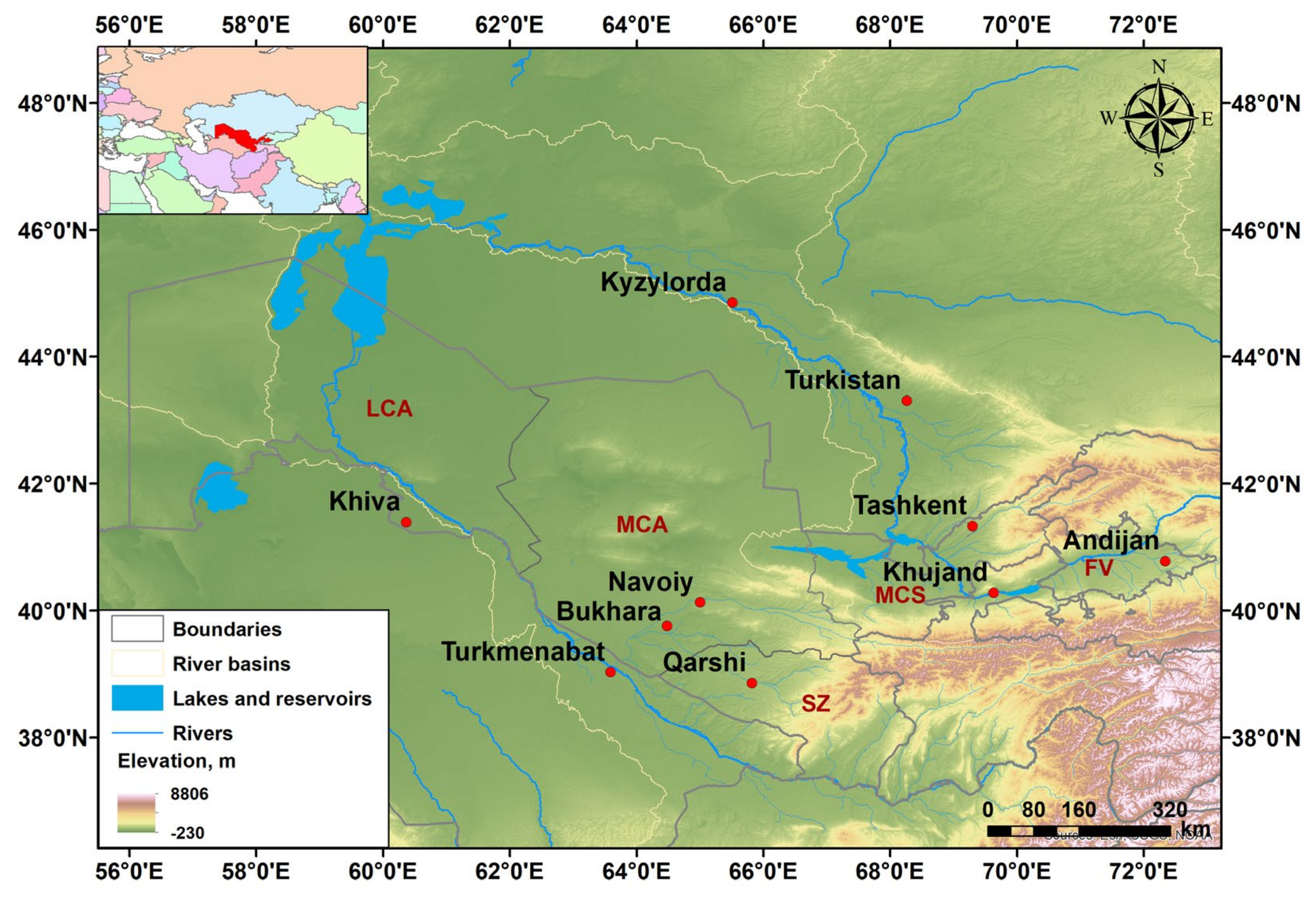
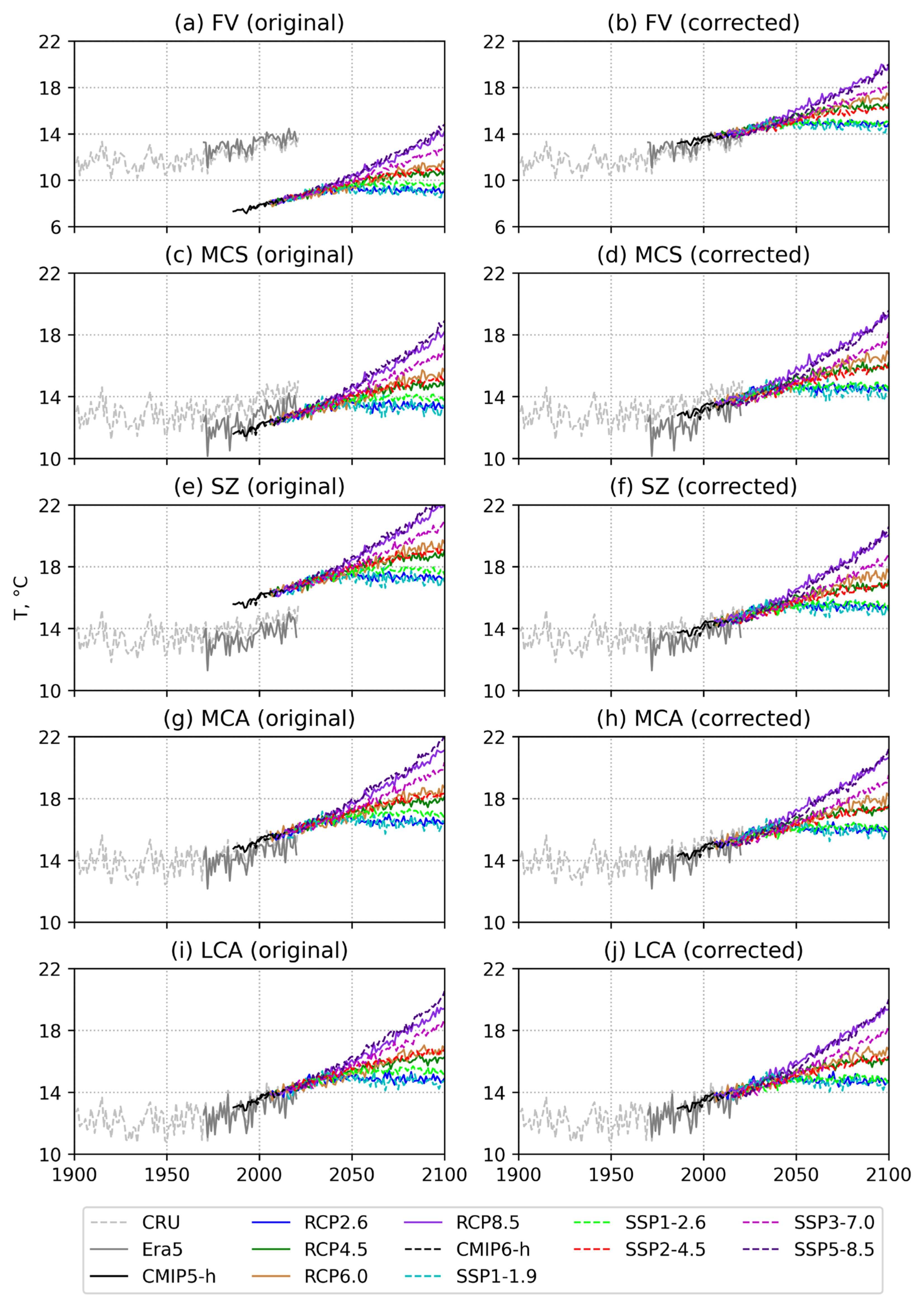
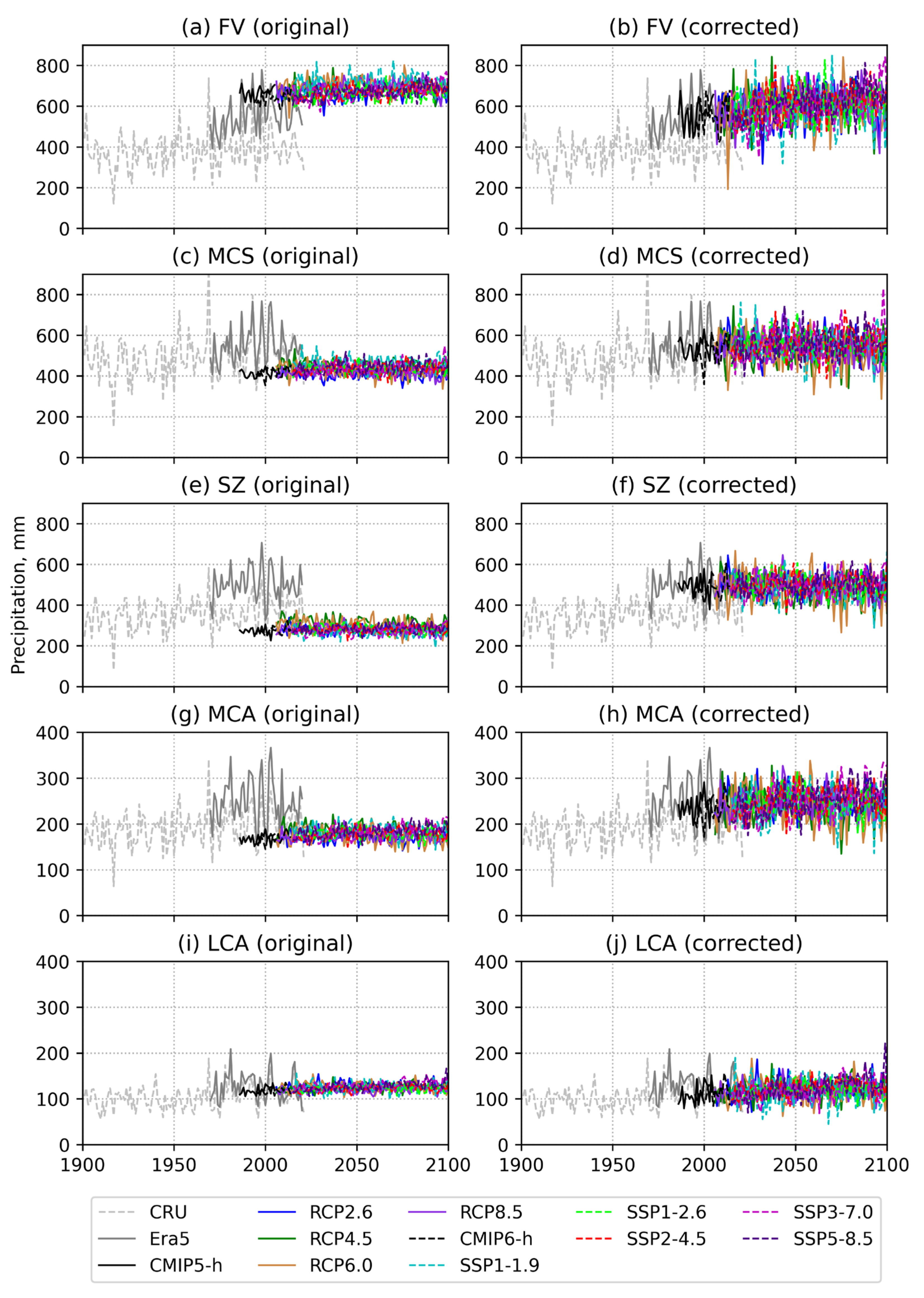
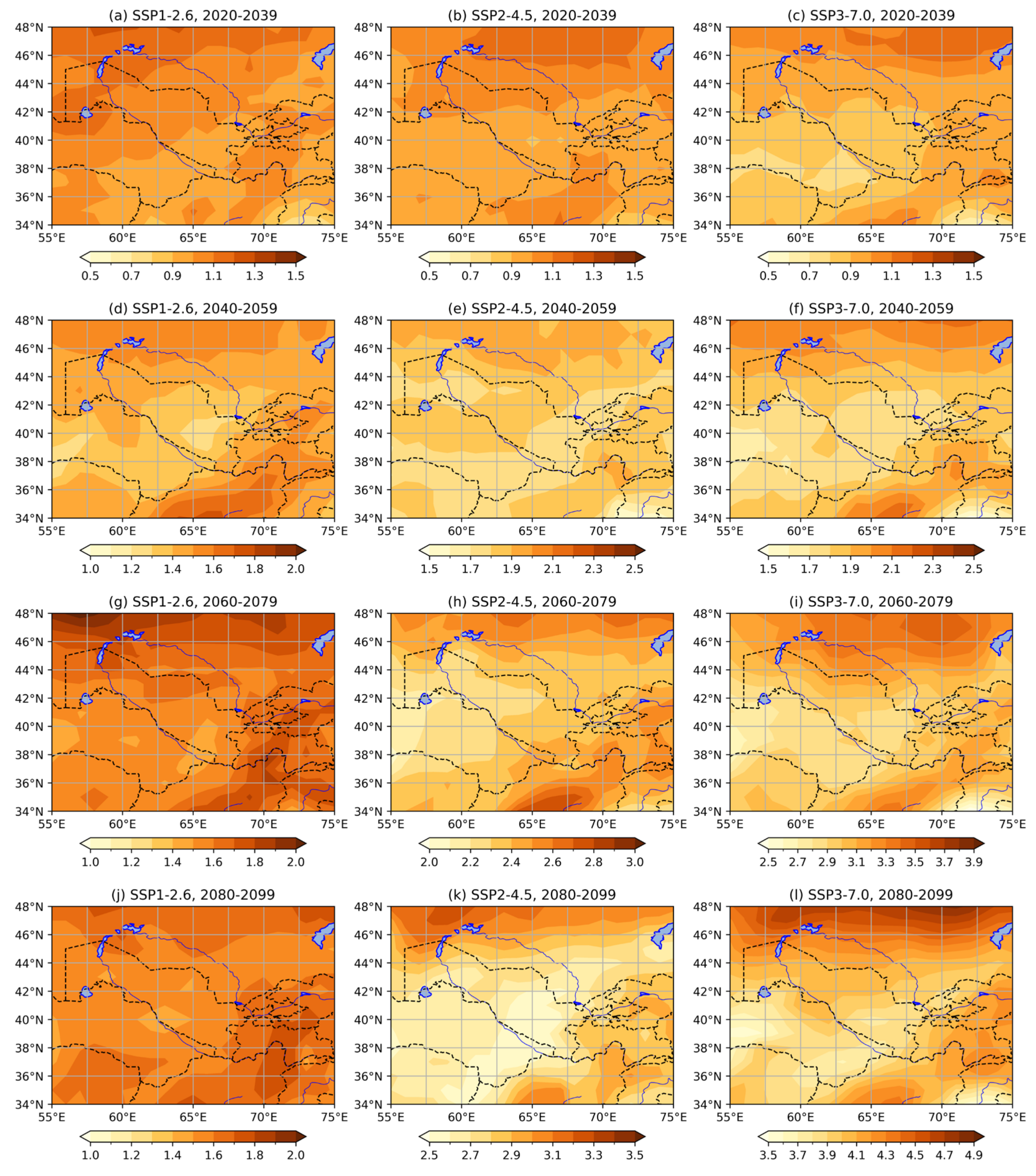

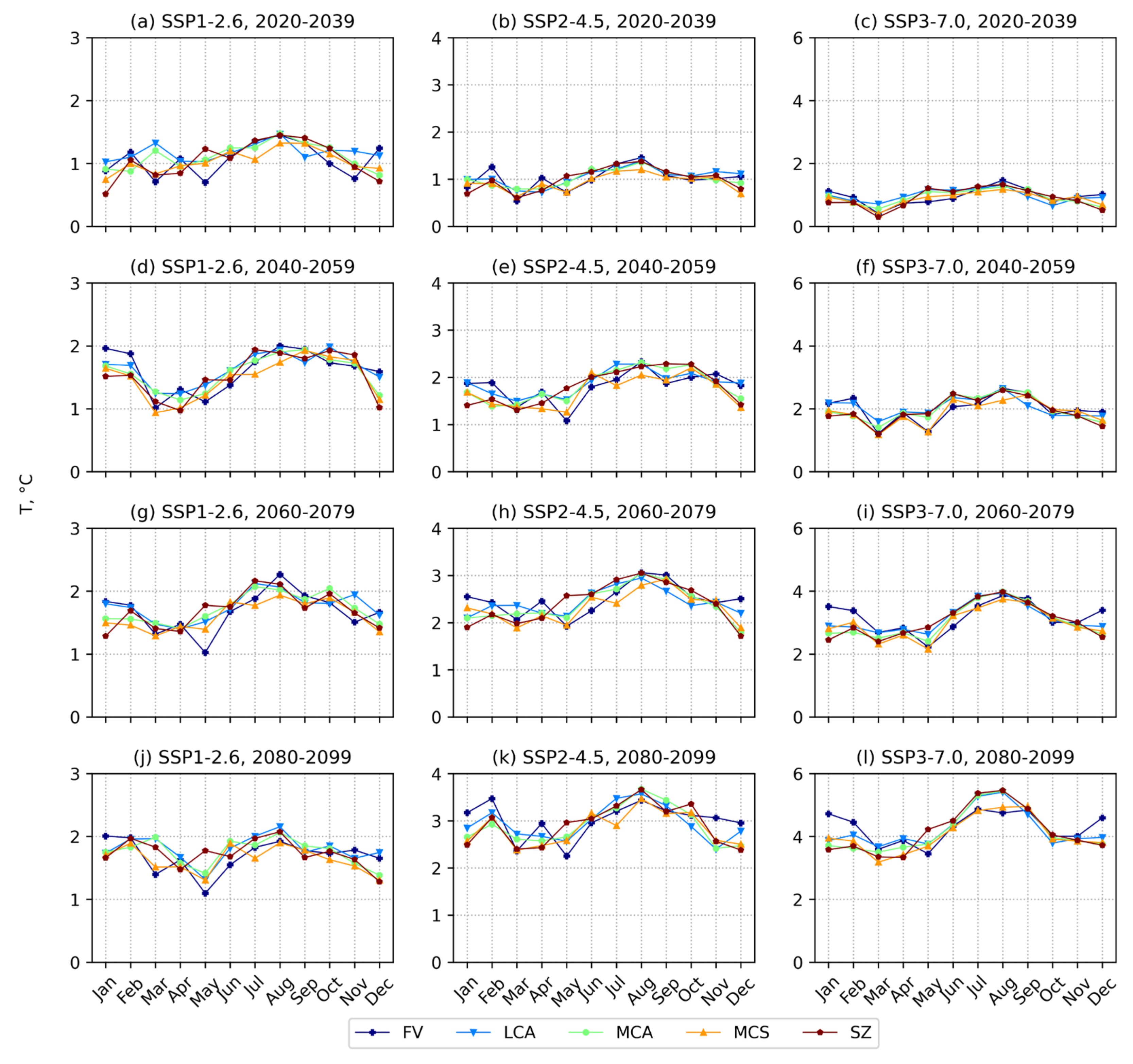
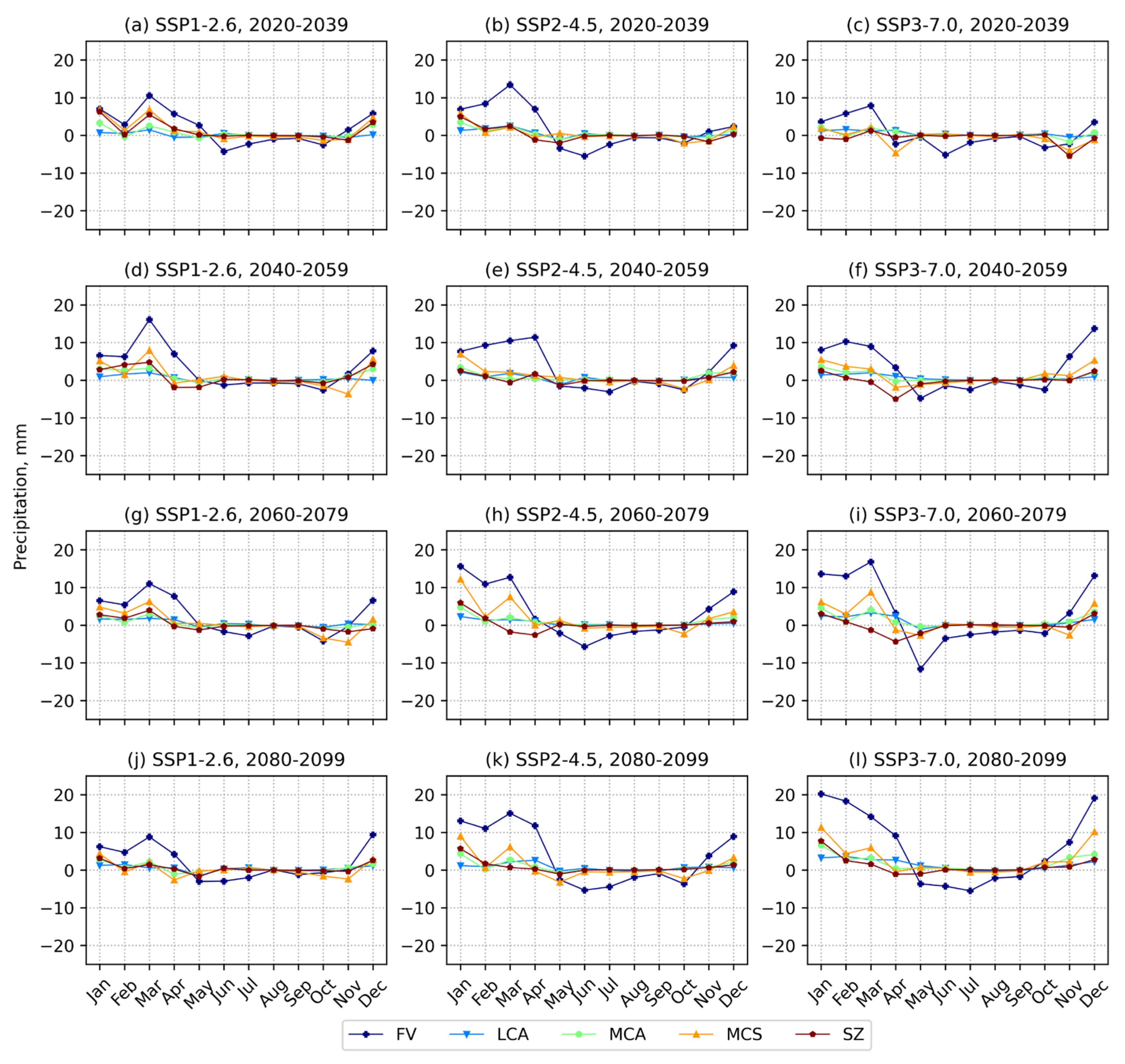
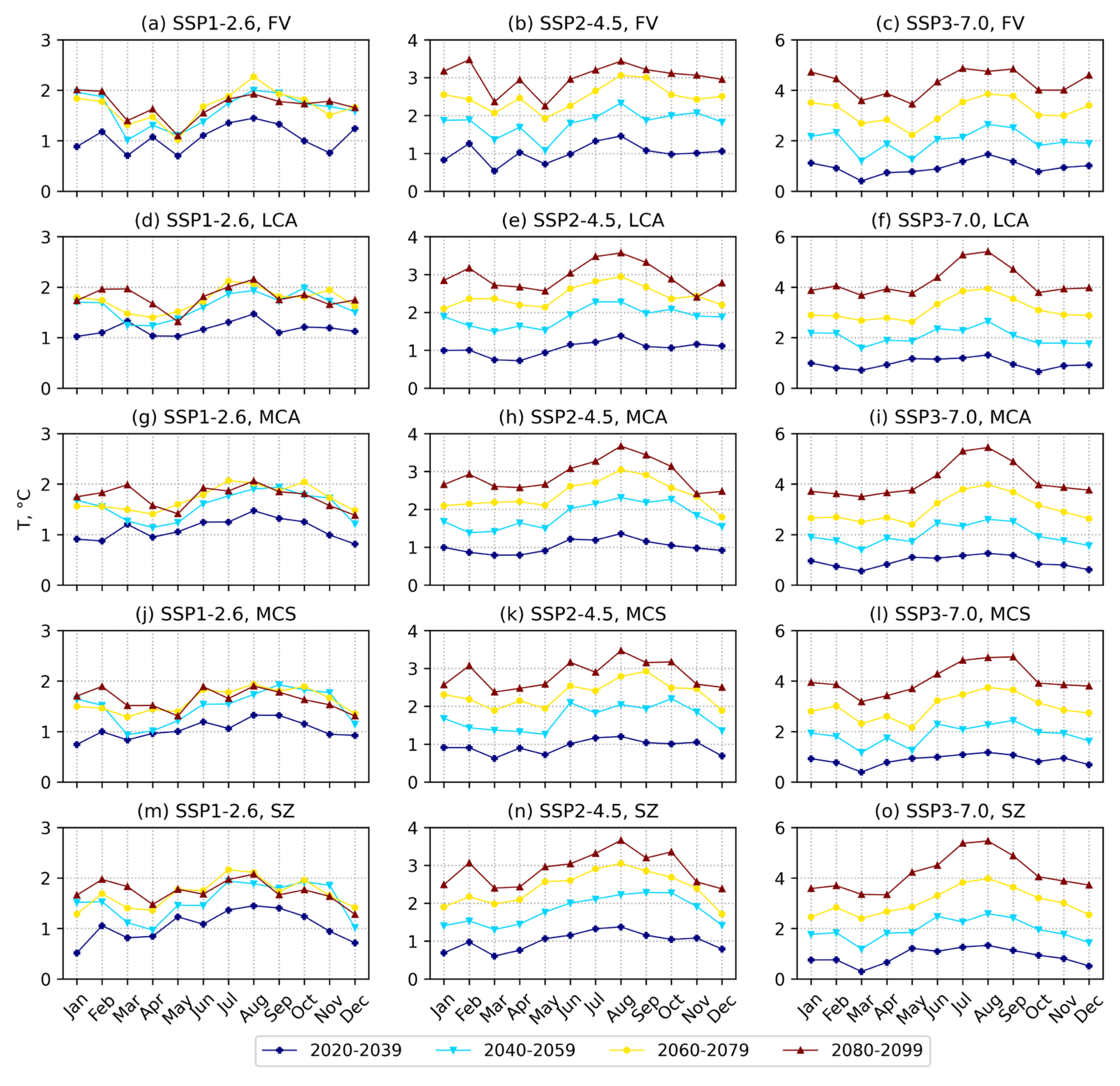

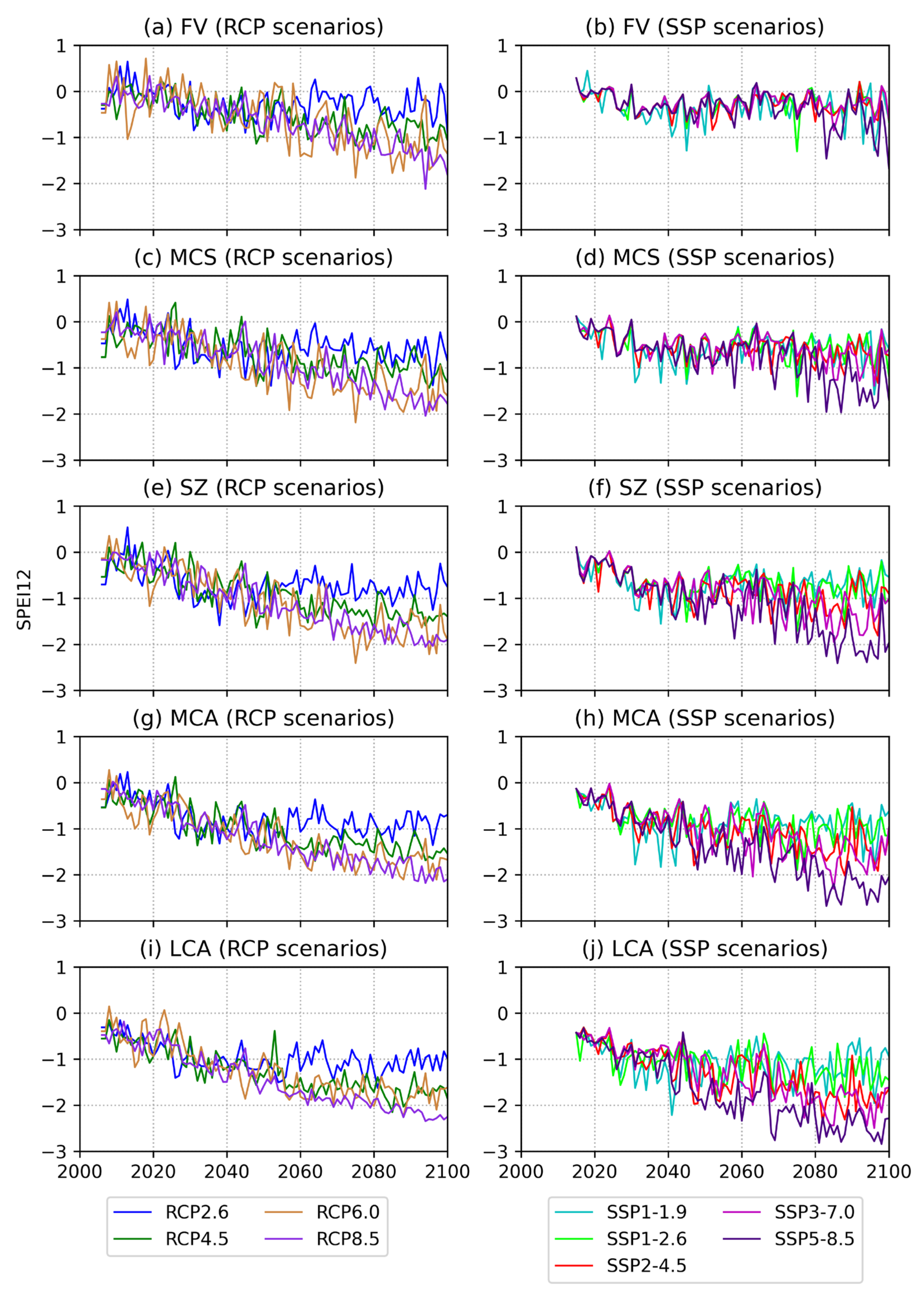
| The SPEI Value | Grade |
|---|---|
| ≤2 | Extreme humidity |
| 1.5–2.0 | High humidity |
| 1.0–1.5 | Moderate humidity |
| 0.5–1.0 | Minor humidity |
| 0.5–−0.5 | Near normal |
| −0.5–−1.0 | Mild drought |
| −1.0–−1.5 | Moderate drought |
| −1.5–−2.0 | Severe drought |
| ≤−2 | Extreme drought |
Disclaimer/Publisher’s Note: The statements, opinions and data contained in all publications are solely those of the individual author(s) and contributor(s) and not of MDPI and/or the editor(s). MDPI and/or the editor(s) disclaim responsibility for any injury to people or property resulting from any ideas, methods, instructions or products referred to in the content. |
© 2024 by the authors. Licensee MDPI, Basel, Switzerland. This article is an open access article distributed under the terms and conditions of the Creative Commons Attribution (CC BY) license (https://creativecommons.org/licenses/by/4.0/).
Share and Cite
Rakhmatova, N.; Nishonov, B.E.; Kholmatjanov, B.M.; Rakhmatova, V.; Toderich, K.N.; Khasankhanova, G.M.; Shardakova, L.; Khujanazarov, T.; Ungalov, A.N.; Belikov, D.A. Assessing the Potential Impacts of Climate Change on Drought in Uzbekistan: Findings from RCP and SSP Scenarios. Atmosphere 2024, 15, 866. https://doi.org/10.3390/atmos15070866
Rakhmatova N, Nishonov BE, Kholmatjanov BM, Rakhmatova V, Toderich KN, Khasankhanova GM, Shardakova L, Khujanazarov T, Ungalov AN, Belikov DA. Assessing the Potential Impacts of Climate Change on Drought in Uzbekistan: Findings from RCP and SSP Scenarios. Atmosphere. 2024; 15(7):866. https://doi.org/10.3390/atmos15070866
Chicago/Turabian StyleRakhmatova, Natella, Bakhriddin E. Nishonov, Bakhtiyar M. Kholmatjanov, Valeriya Rakhmatova, Kristina N. Toderich, Gulchekhra M. Khasankhanova, Lyudmila Shardakova, Temur Khujanazarov, Akmal N. Ungalov, and Dmitry A. Belikov. 2024. "Assessing the Potential Impacts of Climate Change on Drought in Uzbekistan: Findings from RCP and SSP Scenarios" Atmosphere 15, no. 7: 866. https://doi.org/10.3390/atmos15070866






